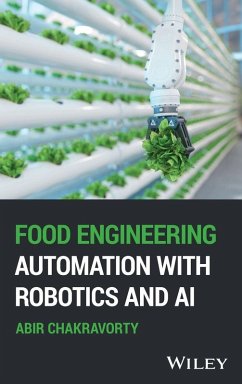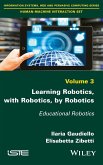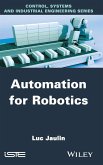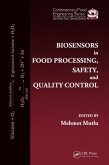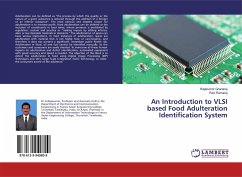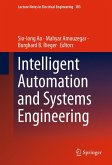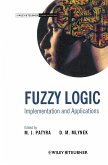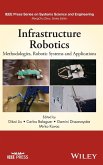Abir Chakravorty
Food Engineering Automation with Robotics and AI
Abir Chakravorty
Food Engineering Automation with Robotics and AI
- Gebundenes Buch
- Merkliste
- Auf die Merkliste
- Bewerten Bewerten
- Teilen
- Produkt teilen
- Produkterinnerung
- Produkterinnerung
Revolutionize food manufacturing with the latest in automating technology Virtually every area of industry has been transformed by robotics and AI, which have automated production and increased efficiency in myriad ways. Until recently, food manufacturing was an exception to the trend. At present, however, the food manufacturing industry is in the process of a transformation which will see automation deliver the same levels of productivity and uniformity that have revolutionized other sectors of the economy. Food Engineering Automation with Robotics and AI is a comprehensive introduction to…mehr
Andere Kunden interessierten sich auch für
![Learning Robotics, with Robotics, by Robotics Learning Robotics, with Robotics, by Robotics]() Ilaria GaudielloLearning Robotics, with Robotics, by Robotics158,99 €
Ilaria GaudielloLearning Robotics, with Robotics, by Robotics158,99 €![Automation for Robotics Automation for Robotics]() Luc JaulinAutomation for Robotics158,99 €
Luc JaulinAutomation for Robotics158,99 €![Biosensors in Food Processing, Safety, and Quality Control Biosensors in Food Processing, Safety, and Quality Control]() Biosensors in Food Processing, Safety, and Quality Control168,99 €
Biosensors in Food Processing, Safety, and Quality Control168,99 €![An Introduction to VLSI based Food Adulteration Identification System An Introduction to VLSI based Food Adulteration Identification System]() Rajakumar GnanarajAn Introduction to VLSI based Food Adulteration Identification System27,99 €
Rajakumar GnanarajAn Introduction to VLSI based Food Adulteration Identification System27,99 €![Intelligent Automation and Systems Engineering Intelligent Automation and Systems Engineering]() Intelligent Automation and Systems Engineering113,99 €
Intelligent Automation and Systems Engineering113,99 €![Fuzzy Logic Fuzzy Logic]() Fuzzy Logic319,99 €
Fuzzy Logic319,99 €![Infrastructure Robotics Infrastructure Robotics]() LiuInfrastructure Robotics128,99 €
LiuInfrastructure Robotics128,99 €-
-
-
Revolutionize food manufacturing with the latest in automating technology Virtually every area of industry has been transformed by robotics and AI, which have automated production and increased efficiency in myriad ways. Until recently, food manufacturing was an exception to the trend. At present, however, the food manufacturing industry is in the process of a transformation which will see automation deliver the same levels of productivity and uniformity that have revolutionized other sectors of the economy. Food Engineering Automation with Robotics and AI is a comprehensive introduction to the areas of intersection between cutting-edge technologies and food manufacturing. Beginning with an overview of the basic principles of food engineering, the book then details applications of robotics and AI in this field, along with the way automation is integrated at every stage of food production. The structure of the book seamlessly blends theory and practice to maximize reader capacity to put its lessons into motion. Food Engineering Automation with Robotics and AI readers will also find: * Content aligning with several UN Sustainable Development Goals, including Zero Hunger; Industry, Innovation, and Infrastructure; and Responsible Consumption and Production * Real-world case studies throughout to show automating technologies revolutionizing food production * A consistent focus on sustainable food engineering, with attention to resource conservation, waste reduction, environmental impact mitigation, and more Food Engineering Automation with Robotics and AI is ideal for the growing, global market for food automation technologies in the coming years.
Produktdetails
- Produktdetails
- Verlag: Wiley
- Seitenzahl: 496
- Erscheinungstermin: 30. September 2025
- Englisch
- Abmessung: 229mm x 152mm x 27mm
- Gewicht: 826g
- ISBN-13: 9781394316564
- ISBN-10: 1394316569
- Artikelnr.: 72073429
- Herstellerkennzeichnung
- Libri GmbH
- Europaallee 1
- 36244 Bad Hersfeld
- gpsr@libri.de
- Verlag: Wiley
- Seitenzahl: 496
- Erscheinungstermin: 30. September 2025
- Englisch
- Abmessung: 229mm x 152mm x 27mm
- Gewicht: 826g
- ISBN-13: 9781394316564
- ISBN-10: 1394316569
- Artikelnr.: 72073429
- Herstellerkennzeichnung
- Libri GmbH
- Europaallee 1
- 36244 Bad Hersfeld
- gpsr@libri.de
Abir Chakravorty, PhD, M.Tech, works in the field of automation, robotics, and food equipment machinery design in the Agricultural and Food Engineering Department, Indian Institute of Technology Kharagpur. He received his PhD from the Department of Mechanical Engineering, IIT Kharagpur. He has three patents filed, one granted, fifteen and more journals, and a book published in his name.
About the Book xix
Preface xxi
Acknowledgments xxiii
About the Author xxv
Acronyms xxvii
Introduction xxix
1 Robotics and Automation in Food Processing, Developments Prompted by the
Present Era Industrial Revolution 1
1.1 Abridgement of the Existing Obstacles and Opportunities Presented by
the Present Era Industrial Revolution in
the Food Processing Sector 1
1.2 Adoption of Technology in Food Processing and Key Industry Technologies
3
1.3 Definition of Robot and Its Various Classification 4
1.4 Use of Robotics in Food Processing 10
1.5 Use of Smart Sensors in Food Processing 11
1.6 Applications of AI in Food Processing 13
1.7 Homogeneous Transformation Matrices 16
1.8 Denavit-Hartenberg Parameters 24
1.9 Degrees of Freedom 25
1.10 Applications of IoT in Food Processing 26
1.11 Prediction Models in Measuring Color and Food Quality 28
1.12 AI/ ML Prediction Modeling in Food Processing and Food Safety 30
1.13 AI/ ML Prediction Modeling in Food Processing and Food Safety 31
1.14 Case Studies 32
1.15 Review Questions 33
2 Automation in Food Processing Applications 37
2.1 Automatic Control of Food Chilling and Freezing 39
2.2 Introduction: Main Forces Behind and Obstacles to Automated Food
Freezing and Chilling Control 41
2.3 Challenges to Automation in Food Chilling and Freezing Include 42
2.4 Automation in Refrigerated Food Retail Display 42
2.5 Automation of Refrigeration and Freezing Operations in Food Catering 44
2.6 Automation in Refrigerated Food Transport Systems 45
2.7 Automation in Food Chilling and Freezing Systems 47
2.8 Automation in Food Cold Storage Systems 48
2.9 Advances in Research and Future Trends 49
2.10 Case Study 50
2.11 Review Questions 52
3 Robot Types and Their Classification 55
3.1 Categories of Robots 56
3.2 Design of IoT-based Pick-and-place Robot 57
3.3 Direct Kinematics 57
3.4 Inverse Kinematics 60
3.5 Inverse Kinematics of a T hree-degrees-of-freedom Spatial Manipulator
with a Unique Geometry 60
3.6 Splines in Robotics 65
3.7 Automation and Its Types 70
3.8 Basic Image Processing Techniques 73
3.9 Robot Kinematics 78
3.10 AI/ML Basics for Food Processing 92
3.11 Mapping, Navigation, and Obstacle Avoidance 105
3.12 Fuzzy Logic Control Case Study in Food Processing 107
3.13 Dijkstra's Algorithm for a Grid Map 108
3.14 Path Planning with the A* Algorithm 109
3.15 Path Following and Obstacle Avoidance 113
3.16 Fuzzy Logic Control 114
3.17 Robotic Motion and Odometry 117
3.18 Gripper: Its Various Types and Applications 119
3.19 Robotics and Automation for Packaging and Handling 129
3.20 Review Questions 132
4 AI/ML and Robotics Applications in Food Safety, Quality, and Challenges
137
4.1 Food Safety and Quality Detection Using Robotics and AI/ML 139
4.2 Automation of Fruit and Vegetable Sorting, Grading 142
4.3 Prediction Models in Measuring Color and Food Quality 144
4.4 Data Management and Its Importance 145
4.5 Ethics and Safety 145
4.6 Adoption of Automation in Food Process Engineering 146
4.7 Automation, Economic Return, Food Manufacturing Sector, Increased
Safety Assurance, and Quality of Products 147
4.8 AI, Robotics, and Automation for UN Sustainable Development Goals 147
4.9 AI in Food Supply Chain, Tracing/ Warehouse/ Distribution 150
4.10 Data Analysis, Discrete and Continuous Data on Classification and
Regression 150
4.11 Case Studies 151
4.12 Review Questions 153
5 Application of Robotics in Processing Meat, Fish, and Poultry 155
5.1 Introduction 155
5.2 Application of Robotics in Processing Meat, Fish, and Poultry 156
5.3 Robotic Manipulator in Food Processing 188
5.4 End Effectors in Food Industry 195
5.5 Robotic and Vision Systems in Use for Fish Processing 204
5.6 Review Questions 229
6 Principles of Fuzzy PID and Its Algorithm 233
6.1 Fresh Food Atmosphere Packaging Gas Distribution System Utilizing Fuzzy
PID Control 233
6.2 A Fuzzy-PID Controller for Temperature Control in a Shell and Tube Heat
Exchanger Simulation 238
6.3 An Introduction to Automated Process Control in the Food Sector Using
Supervisory Control and Data Acquisition and Associated Systems 249
6.4 Introduction to SCADA 250
6.5 SCADA and Its History 251
6.6 SCADA Standards and Applications 252
6.7 SCADA in Food Processing 252
6.8 Laboratory Study: Implementation of SCADA 253
6.9 Future Trends in SCADA 254
6.10 Review Questions 258
7 Robots, Ladder Elements, Logic Gates, 3D Food Printing, SCADA, Automation
Pyramid in Food Processing 259
7.1 3D Printing Technology: The New Era for Food Customization and
Elaboration 259
7.2 Environmentally Friendly and Sustainable Technology 265
7.3 Autonomous Mobile Robots 266
7.4 Review Questions 291
8 PID Control Techniques in Food Processing 293
8.1 Process Control Methods in the Food Industry 294
8.2 Industrial PID Control 299
8.3 Variations of PID Controller Algorithms 303
8.4 Three-term Control, or Proportional, Integral, or Derivative Control
306
8.5 Parallel PID Controllers in Food Processing 307
8.6 Review Questions 359
9 Online Spectroscopy Techniques to Access Food Quality and Safety, SCADA
and HMI Examples 363
9.1 AI/ML Techniques for Food Safety Case Studies 364
9.2 Sensors for Automated Food Process Control 381
9.3 Review Questions 420
10 Case Studies 425
10.1 Modeling Simulation and Practical Application of Robotics in Food
Manufacturing Different Simulation Scenario 426
10.2 Robotic Cooking 430
10.3 Robotic Arm Control and Task Training Through Deep Reinforcement
Learning 431
10.4 Sensors for Automated Food Process Control 433
10.5 Indirect Teaching of the Robot Hand 435
10.6 Tuning Humanoid Walking Parameters for Food Service Robots for Better
Performance 437
10.7 Sensorized Compliant Robot Gripper for Estimating the Cooking Time of
Boil-cooked Vegetables 439
10.8 Multiple Object Detection and Segmentation for Automated Removal in
Additive Manufacturing with Service Robots 441
10.9 Miscellaneous Case Studies 442
10.10 Review Questions 446
Bibliography 446
Appendix: List of Suppliers for Sensors and Automation Equipment 449
Index 455
Preface xxi
Acknowledgments xxiii
About the Author xxv
Acronyms xxvii
Introduction xxix
1 Robotics and Automation in Food Processing, Developments Prompted by the
Present Era Industrial Revolution 1
1.1 Abridgement of the Existing Obstacles and Opportunities Presented by
the Present Era Industrial Revolution in
the Food Processing Sector 1
1.2 Adoption of Technology in Food Processing and Key Industry Technologies
3
1.3 Definition of Robot and Its Various Classification 4
1.4 Use of Robotics in Food Processing 10
1.5 Use of Smart Sensors in Food Processing 11
1.6 Applications of AI in Food Processing 13
1.7 Homogeneous Transformation Matrices 16
1.8 Denavit-Hartenberg Parameters 24
1.9 Degrees of Freedom 25
1.10 Applications of IoT in Food Processing 26
1.11 Prediction Models in Measuring Color and Food Quality 28
1.12 AI/ ML Prediction Modeling in Food Processing and Food Safety 30
1.13 AI/ ML Prediction Modeling in Food Processing and Food Safety 31
1.14 Case Studies 32
1.15 Review Questions 33
2 Automation in Food Processing Applications 37
2.1 Automatic Control of Food Chilling and Freezing 39
2.2 Introduction: Main Forces Behind and Obstacles to Automated Food
Freezing and Chilling Control 41
2.3 Challenges to Automation in Food Chilling and Freezing Include 42
2.4 Automation in Refrigerated Food Retail Display 42
2.5 Automation of Refrigeration and Freezing Operations in Food Catering 44
2.6 Automation in Refrigerated Food Transport Systems 45
2.7 Automation in Food Chilling and Freezing Systems 47
2.8 Automation in Food Cold Storage Systems 48
2.9 Advances in Research and Future Trends 49
2.10 Case Study 50
2.11 Review Questions 52
3 Robot Types and Their Classification 55
3.1 Categories of Robots 56
3.2 Design of IoT-based Pick-and-place Robot 57
3.3 Direct Kinematics 57
3.4 Inverse Kinematics 60
3.5 Inverse Kinematics of a T hree-degrees-of-freedom Spatial Manipulator
with a Unique Geometry 60
3.6 Splines in Robotics 65
3.7 Automation and Its Types 70
3.8 Basic Image Processing Techniques 73
3.9 Robot Kinematics 78
3.10 AI/ML Basics for Food Processing 92
3.11 Mapping, Navigation, and Obstacle Avoidance 105
3.12 Fuzzy Logic Control Case Study in Food Processing 107
3.13 Dijkstra's Algorithm for a Grid Map 108
3.14 Path Planning with the A* Algorithm 109
3.15 Path Following and Obstacle Avoidance 113
3.16 Fuzzy Logic Control 114
3.17 Robotic Motion and Odometry 117
3.18 Gripper: Its Various Types and Applications 119
3.19 Robotics and Automation for Packaging and Handling 129
3.20 Review Questions 132
4 AI/ML and Robotics Applications in Food Safety, Quality, and Challenges
137
4.1 Food Safety and Quality Detection Using Robotics and AI/ML 139
4.2 Automation of Fruit and Vegetable Sorting, Grading 142
4.3 Prediction Models in Measuring Color and Food Quality 144
4.4 Data Management and Its Importance 145
4.5 Ethics and Safety 145
4.6 Adoption of Automation in Food Process Engineering 146
4.7 Automation, Economic Return, Food Manufacturing Sector, Increased
Safety Assurance, and Quality of Products 147
4.8 AI, Robotics, and Automation for UN Sustainable Development Goals 147
4.9 AI in Food Supply Chain, Tracing/ Warehouse/ Distribution 150
4.10 Data Analysis, Discrete and Continuous Data on Classification and
Regression 150
4.11 Case Studies 151
4.12 Review Questions 153
5 Application of Robotics in Processing Meat, Fish, and Poultry 155
5.1 Introduction 155
5.2 Application of Robotics in Processing Meat, Fish, and Poultry 156
5.3 Robotic Manipulator in Food Processing 188
5.4 End Effectors in Food Industry 195
5.5 Robotic and Vision Systems in Use for Fish Processing 204
5.6 Review Questions 229
6 Principles of Fuzzy PID and Its Algorithm 233
6.1 Fresh Food Atmosphere Packaging Gas Distribution System Utilizing Fuzzy
PID Control 233
6.2 A Fuzzy-PID Controller for Temperature Control in a Shell and Tube Heat
Exchanger Simulation 238
6.3 An Introduction to Automated Process Control in the Food Sector Using
Supervisory Control and Data Acquisition and Associated Systems 249
6.4 Introduction to SCADA 250
6.5 SCADA and Its History 251
6.6 SCADA Standards and Applications 252
6.7 SCADA in Food Processing 252
6.8 Laboratory Study: Implementation of SCADA 253
6.9 Future Trends in SCADA 254
6.10 Review Questions 258
7 Robots, Ladder Elements, Logic Gates, 3D Food Printing, SCADA, Automation
Pyramid in Food Processing 259
7.1 3D Printing Technology: The New Era for Food Customization and
Elaboration 259
7.2 Environmentally Friendly and Sustainable Technology 265
7.3 Autonomous Mobile Robots 266
7.4 Review Questions 291
8 PID Control Techniques in Food Processing 293
8.1 Process Control Methods in the Food Industry 294
8.2 Industrial PID Control 299
8.3 Variations of PID Controller Algorithms 303
8.4 Three-term Control, or Proportional, Integral, or Derivative Control
306
8.5 Parallel PID Controllers in Food Processing 307
8.6 Review Questions 359
9 Online Spectroscopy Techniques to Access Food Quality and Safety, SCADA
and HMI Examples 363
9.1 AI/ML Techniques for Food Safety Case Studies 364
9.2 Sensors for Automated Food Process Control 381
9.3 Review Questions 420
10 Case Studies 425
10.1 Modeling Simulation and Practical Application of Robotics in Food
Manufacturing Different Simulation Scenario 426
10.2 Robotic Cooking 430
10.3 Robotic Arm Control and Task Training Through Deep Reinforcement
Learning 431
10.4 Sensors for Automated Food Process Control 433
10.5 Indirect Teaching of the Robot Hand 435
10.6 Tuning Humanoid Walking Parameters for Food Service Robots for Better
Performance 437
10.7 Sensorized Compliant Robot Gripper for Estimating the Cooking Time of
Boil-cooked Vegetables 439
10.8 Multiple Object Detection and Segmentation for Automated Removal in
Additive Manufacturing with Service Robots 441
10.9 Miscellaneous Case Studies 442
10.10 Review Questions 446
Bibliography 446
Appendix: List of Suppliers for Sensors and Automation Equipment 449
Index 455
About the Book xix
Preface xxi
Acknowledgments xxiii
About the Author xxv
Acronyms xxvii
Introduction xxix
1 Robotics and Automation in Food Processing, Developments Prompted by the
Present Era Industrial Revolution 1
1.1 Abridgement of the Existing Obstacles and Opportunities Presented by
the Present Era Industrial Revolution in
the Food Processing Sector 1
1.2 Adoption of Technology in Food Processing and Key Industry Technologies
3
1.3 Definition of Robot and Its Various Classification 4
1.4 Use of Robotics in Food Processing 10
1.5 Use of Smart Sensors in Food Processing 11
1.6 Applications of AI in Food Processing 13
1.7 Homogeneous Transformation Matrices 16
1.8 Denavit-Hartenberg Parameters 24
1.9 Degrees of Freedom 25
1.10 Applications of IoT in Food Processing 26
1.11 Prediction Models in Measuring Color and Food Quality 28
1.12 AI/ ML Prediction Modeling in Food Processing and Food Safety 30
1.13 AI/ ML Prediction Modeling in Food Processing and Food Safety 31
1.14 Case Studies 32
1.15 Review Questions 33
2 Automation in Food Processing Applications 37
2.1 Automatic Control of Food Chilling and Freezing 39
2.2 Introduction: Main Forces Behind and Obstacles to Automated Food
Freezing and Chilling Control 41
2.3 Challenges to Automation in Food Chilling and Freezing Include 42
2.4 Automation in Refrigerated Food Retail Display 42
2.5 Automation of Refrigeration and Freezing Operations in Food Catering 44
2.6 Automation in Refrigerated Food Transport Systems 45
2.7 Automation in Food Chilling and Freezing Systems 47
2.8 Automation in Food Cold Storage Systems 48
2.9 Advances in Research and Future Trends 49
2.10 Case Study 50
2.11 Review Questions 52
3 Robot Types and Their Classification 55
3.1 Categories of Robots 56
3.2 Design of IoT-based Pick-and-place Robot 57
3.3 Direct Kinematics 57
3.4 Inverse Kinematics 60
3.5 Inverse Kinematics of a T hree-degrees-of-freedom Spatial Manipulator
with a Unique Geometry 60
3.6 Splines in Robotics 65
3.7 Automation and Its Types 70
3.8 Basic Image Processing Techniques 73
3.9 Robot Kinematics 78
3.10 AI/ML Basics for Food Processing 92
3.11 Mapping, Navigation, and Obstacle Avoidance 105
3.12 Fuzzy Logic Control Case Study in Food Processing 107
3.13 Dijkstra's Algorithm for a Grid Map 108
3.14 Path Planning with the A* Algorithm 109
3.15 Path Following and Obstacle Avoidance 113
3.16 Fuzzy Logic Control 114
3.17 Robotic Motion and Odometry 117
3.18 Gripper: Its Various Types and Applications 119
3.19 Robotics and Automation for Packaging and Handling 129
3.20 Review Questions 132
4 AI/ML and Robotics Applications in Food Safety, Quality, and Challenges
137
4.1 Food Safety and Quality Detection Using Robotics and AI/ML 139
4.2 Automation of Fruit and Vegetable Sorting, Grading 142
4.3 Prediction Models in Measuring Color and Food Quality 144
4.4 Data Management and Its Importance 145
4.5 Ethics and Safety 145
4.6 Adoption of Automation in Food Process Engineering 146
4.7 Automation, Economic Return, Food Manufacturing Sector, Increased
Safety Assurance, and Quality of Products 147
4.8 AI, Robotics, and Automation for UN Sustainable Development Goals 147
4.9 AI in Food Supply Chain, Tracing/ Warehouse/ Distribution 150
4.10 Data Analysis, Discrete and Continuous Data on Classification and
Regression 150
4.11 Case Studies 151
4.12 Review Questions 153
5 Application of Robotics in Processing Meat, Fish, and Poultry 155
5.1 Introduction 155
5.2 Application of Robotics in Processing Meat, Fish, and Poultry 156
5.3 Robotic Manipulator in Food Processing 188
5.4 End Effectors in Food Industry 195
5.5 Robotic and Vision Systems in Use for Fish Processing 204
5.6 Review Questions 229
6 Principles of Fuzzy PID and Its Algorithm 233
6.1 Fresh Food Atmosphere Packaging Gas Distribution System Utilizing Fuzzy
PID Control 233
6.2 A Fuzzy-PID Controller for Temperature Control in a Shell and Tube Heat
Exchanger Simulation 238
6.3 An Introduction to Automated Process Control in the Food Sector Using
Supervisory Control and Data Acquisition and Associated Systems 249
6.4 Introduction to SCADA 250
6.5 SCADA and Its History 251
6.6 SCADA Standards and Applications 252
6.7 SCADA in Food Processing 252
6.8 Laboratory Study: Implementation of SCADA 253
6.9 Future Trends in SCADA 254
6.10 Review Questions 258
7 Robots, Ladder Elements, Logic Gates, 3D Food Printing, SCADA, Automation
Pyramid in Food Processing 259
7.1 3D Printing Technology: The New Era for Food Customization and
Elaboration 259
7.2 Environmentally Friendly and Sustainable Technology 265
7.3 Autonomous Mobile Robots 266
7.4 Review Questions 291
8 PID Control Techniques in Food Processing 293
8.1 Process Control Methods in the Food Industry 294
8.2 Industrial PID Control 299
8.3 Variations of PID Controller Algorithms 303
8.4 Three-term Control, or Proportional, Integral, or Derivative Control
306
8.5 Parallel PID Controllers in Food Processing 307
8.6 Review Questions 359
9 Online Spectroscopy Techniques to Access Food Quality and Safety, SCADA
and HMI Examples 363
9.1 AI/ML Techniques for Food Safety Case Studies 364
9.2 Sensors for Automated Food Process Control 381
9.3 Review Questions 420
10 Case Studies 425
10.1 Modeling Simulation and Practical Application of Robotics in Food
Manufacturing Different Simulation Scenario 426
10.2 Robotic Cooking 430
10.3 Robotic Arm Control and Task Training Through Deep Reinforcement
Learning 431
10.4 Sensors for Automated Food Process Control 433
10.5 Indirect Teaching of the Robot Hand 435
10.6 Tuning Humanoid Walking Parameters for Food Service Robots for Better
Performance 437
10.7 Sensorized Compliant Robot Gripper for Estimating the Cooking Time of
Boil-cooked Vegetables 439
10.8 Multiple Object Detection and Segmentation for Automated Removal in
Additive Manufacturing with Service Robots 441
10.9 Miscellaneous Case Studies 442
10.10 Review Questions 446
Bibliography 446
Appendix: List of Suppliers for Sensors and Automation Equipment 449
Index 455
Preface xxi
Acknowledgments xxiii
About the Author xxv
Acronyms xxvii
Introduction xxix
1 Robotics and Automation in Food Processing, Developments Prompted by the
Present Era Industrial Revolution 1
1.1 Abridgement of the Existing Obstacles and Opportunities Presented by
the Present Era Industrial Revolution in
the Food Processing Sector 1
1.2 Adoption of Technology in Food Processing and Key Industry Technologies
3
1.3 Definition of Robot and Its Various Classification 4
1.4 Use of Robotics in Food Processing 10
1.5 Use of Smart Sensors in Food Processing 11
1.6 Applications of AI in Food Processing 13
1.7 Homogeneous Transformation Matrices 16
1.8 Denavit-Hartenberg Parameters 24
1.9 Degrees of Freedom 25
1.10 Applications of IoT in Food Processing 26
1.11 Prediction Models in Measuring Color and Food Quality 28
1.12 AI/ ML Prediction Modeling in Food Processing and Food Safety 30
1.13 AI/ ML Prediction Modeling in Food Processing and Food Safety 31
1.14 Case Studies 32
1.15 Review Questions 33
2 Automation in Food Processing Applications 37
2.1 Automatic Control of Food Chilling and Freezing 39
2.2 Introduction: Main Forces Behind and Obstacles to Automated Food
Freezing and Chilling Control 41
2.3 Challenges to Automation in Food Chilling and Freezing Include 42
2.4 Automation in Refrigerated Food Retail Display 42
2.5 Automation of Refrigeration and Freezing Operations in Food Catering 44
2.6 Automation in Refrigerated Food Transport Systems 45
2.7 Automation in Food Chilling and Freezing Systems 47
2.8 Automation in Food Cold Storage Systems 48
2.9 Advances in Research and Future Trends 49
2.10 Case Study 50
2.11 Review Questions 52
3 Robot Types and Their Classification 55
3.1 Categories of Robots 56
3.2 Design of IoT-based Pick-and-place Robot 57
3.3 Direct Kinematics 57
3.4 Inverse Kinematics 60
3.5 Inverse Kinematics of a T hree-degrees-of-freedom Spatial Manipulator
with a Unique Geometry 60
3.6 Splines in Robotics 65
3.7 Automation and Its Types 70
3.8 Basic Image Processing Techniques 73
3.9 Robot Kinematics 78
3.10 AI/ML Basics for Food Processing 92
3.11 Mapping, Navigation, and Obstacle Avoidance 105
3.12 Fuzzy Logic Control Case Study in Food Processing 107
3.13 Dijkstra's Algorithm for a Grid Map 108
3.14 Path Planning with the A* Algorithm 109
3.15 Path Following and Obstacle Avoidance 113
3.16 Fuzzy Logic Control 114
3.17 Robotic Motion and Odometry 117
3.18 Gripper: Its Various Types and Applications 119
3.19 Robotics and Automation for Packaging and Handling 129
3.20 Review Questions 132
4 AI/ML and Robotics Applications in Food Safety, Quality, and Challenges
137
4.1 Food Safety and Quality Detection Using Robotics and AI/ML 139
4.2 Automation of Fruit and Vegetable Sorting, Grading 142
4.3 Prediction Models in Measuring Color and Food Quality 144
4.4 Data Management and Its Importance 145
4.5 Ethics and Safety 145
4.6 Adoption of Automation in Food Process Engineering 146
4.7 Automation, Economic Return, Food Manufacturing Sector, Increased
Safety Assurance, and Quality of Products 147
4.8 AI, Robotics, and Automation for UN Sustainable Development Goals 147
4.9 AI in Food Supply Chain, Tracing/ Warehouse/ Distribution 150
4.10 Data Analysis, Discrete and Continuous Data on Classification and
Regression 150
4.11 Case Studies 151
4.12 Review Questions 153
5 Application of Robotics in Processing Meat, Fish, and Poultry 155
5.1 Introduction 155
5.2 Application of Robotics in Processing Meat, Fish, and Poultry 156
5.3 Robotic Manipulator in Food Processing 188
5.4 End Effectors in Food Industry 195
5.5 Robotic and Vision Systems in Use for Fish Processing 204
5.6 Review Questions 229
6 Principles of Fuzzy PID and Its Algorithm 233
6.1 Fresh Food Atmosphere Packaging Gas Distribution System Utilizing Fuzzy
PID Control 233
6.2 A Fuzzy-PID Controller for Temperature Control in a Shell and Tube Heat
Exchanger Simulation 238
6.3 An Introduction to Automated Process Control in the Food Sector Using
Supervisory Control and Data Acquisition and Associated Systems 249
6.4 Introduction to SCADA 250
6.5 SCADA and Its History 251
6.6 SCADA Standards and Applications 252
6.7 SCADA in Food Processing 252
6.8 Laboratory Study: Implementation of SCADA 253
6.9 Future Trends in SCADA 254
6.10 Review Questions 258
7 Robots, Ladder Elements, Logic Gates, 3D Food Printing, SCADA, Automation
Pyramid in Food Processing 259
7.1 3D Printing Technology: The New Era for Food Customization and
Elaboration 259
7.2 Environmentally Friendly and Sustainable Technology 265
7.3 Autonomous Mobile Robots 266
7.4 Review Questions 291
8 PID Control Techniques in Food Processing 293
8.1 Process Control Methods in the Food Industry 294
8.2 Industrial PID Control 299
8.3 Variations of PID Controller Algorithms 303
8.4 Three-term Control, or Proportional, Integral, or Derivative Control
306
8.5 Parallel PID Controllers in Food Processing 307
8.6 Review Questions 359
9 Online Spectroscopy Techniques to Access Food Quality and Safety, SCADA
and HMI Examples 363
9.1 AI/ML Techniques for Food Safety Case Studies 364
9.2 Sensors for Automated Food Process Control 381
9.3 Review Questions 420
10 Case Studies 425
10.1 Modeling Simulation and Practical Application of Robotics in Food
Manufacturing Different Simulation Scenario 426
10.2 Robotic Cooking 430
10.3 Robotic Arm Control and Task Training Through Deep Reinforcement
Learning 431
10.4 Sensors for Automated Food Process Control 433
10.5 Indirect Teaching of the Robot Hand 435
10.6 Tuning Humanoid Walking Parameters for Food Service Robots for Better
Performance 437
10.7 Sensorized Compliant Robot Gripper for Estimating the Cooking Time of
Boil-cooked Vegetables 439
10.8 Multiple Object Detection and Segmentation for Automated Removal in
Additive Manufacturing with Service Robots 441
10.9 Miscellaneous Case Studies 442
10.10 Review Questions 446
Bibliography 446
Appendix: List of Suppliers for Sensors and Automation Equipment 449
Index 455

